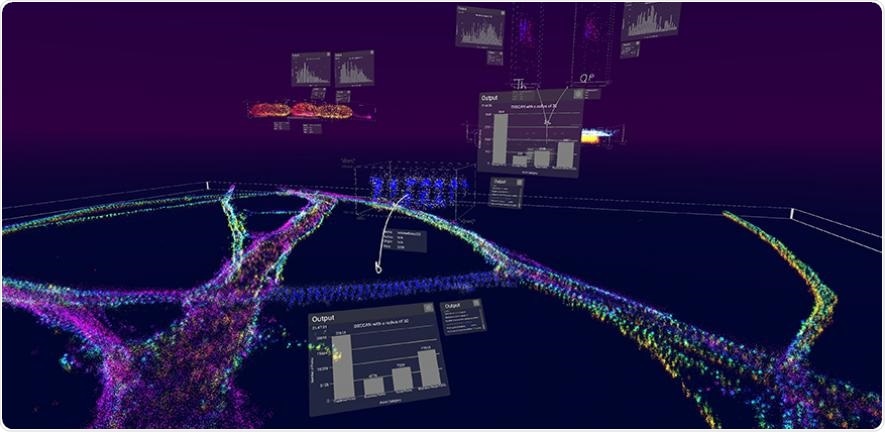New virtual reality software now enables scientists to “walk” inside and examine individual cells. The software could be utilized to figure out the underlying problems in biology and develop new therapies for various diseases.

DBScan analysis being performed a mature neuron in a typical vLUME workspace. Image Credit: Alexandre Kitching.
The novel software, known as vLUME, was developed by a team of researchers from the University of Cambridge and Lume VR Ltd.—a 3D image analysis software company. The software helps visualize and examine super-resolution microscopy data in virtual reality, and can be utilized to analyze everything from entire cells to individual proteins. The study details have been published in the Nature Methods journal.
Super-resolution microscopy received the Nobel Prize for Chemistry in 2014. It allows scientists to acquire nanoscale pictures by using smart tricks of physics to overcome the restrictions imposed by light diffraction. This has enabled researchers to visualize molecular processes as they occur. However, no suitable methods are available to view and examine this information in three dimensions which poses a significant problem,
Biology occurs in 3D, but up until now it has been difficult to interact with the data on a 2D computer screen in an intuitive and immersive way. It wasn’t until we started seeing our data in virtual reality that everything clicked into place.”
Dr Steven F. Lee, Study Lead Researcher, Department of Chemistry, University of Cambridge
The vLUME project was initiated when Lee and his team met with the founders of Lume VR at a public engagement event conducted at the Science Museum in London. Although Lee’s team had the know-how in super-resolution microscopy, the group from Lume VR specialized in data analysis and spatial computing, and together they succeeded in developing the vLUME software into a strong new tool to investigate complex datasets in virtual reality.
vLUME is revolutionary imaging software that brings humans into the nanoscale. It allows scientists to visualise, question and interact with 3D biological data, in real time all within a virtual reality environment, to find answers to biological questions faster. It’s a new tool for new discoveries.”
Alexandre Kitching, CEO, Lume VR Ltd.
Visualizing information in this way can encourage new ideas and initiatives. For instance, Anoushka Handa—a PhD student from Lee’s team—applied the software to image an immune cell collected from her own blood, and later stood inside her own cell in virtual reality.
Handa added, “It’s incredible—it gives you an entirely different perspective on your work.”
The novel software enables scientists to load in multiple datasets containing an unlimited number of data points and detect patterns in the complex data through integrated clustering algorithms. Researchers can subsequently share these findings with colleagues around the world using video and picture features in the software.
Data generated from super-resolution microscopy is extremely complex. For scientists, running analysis on this data can be very time-consuming. With vLUME, we have managed to vastly reduce that wait time allowing for more rapid testing and analysis.”
Alexandre Kitching, CEO, Lume VR Ltd.
The researchers are largely using the vLUME software with biological datasets, like immune cells, neurons, or cancer cells. For instance, Lee’s team has been exploring how antigen cells stimulate an immune reaction in the body.
“Through segmenting and viewing the data in vLUME, we’ve quickly been able to rule out certain hypotheses and propose new ones. This software allows researchers to explore, analyse, segment and share their data in new ways. All you need is a VR headset,” Lee concluded.
Source:
Journal reference:
Spark, A., et al. (2020) vLUME: 3D Virtual Reality for Single-molecule Localization Microscopy. Nature Methods. doi.org/10.1038/s41592-020-0962-1.